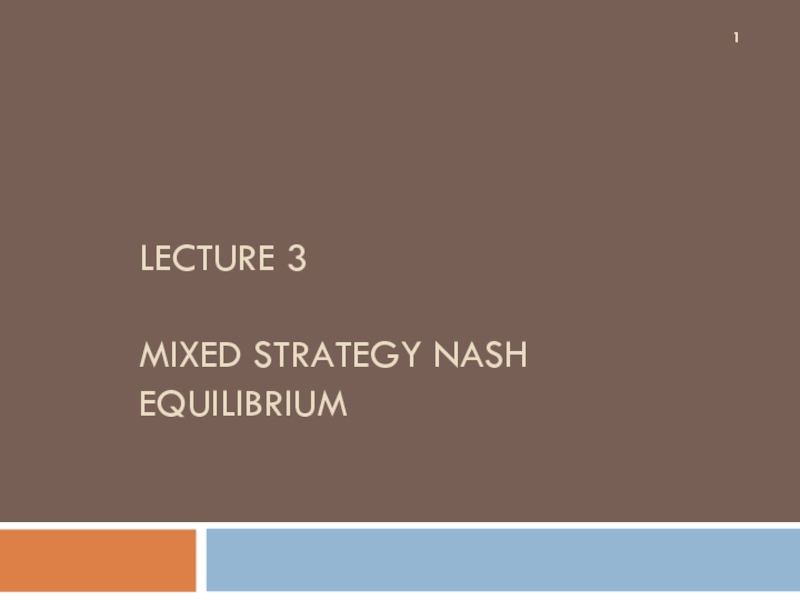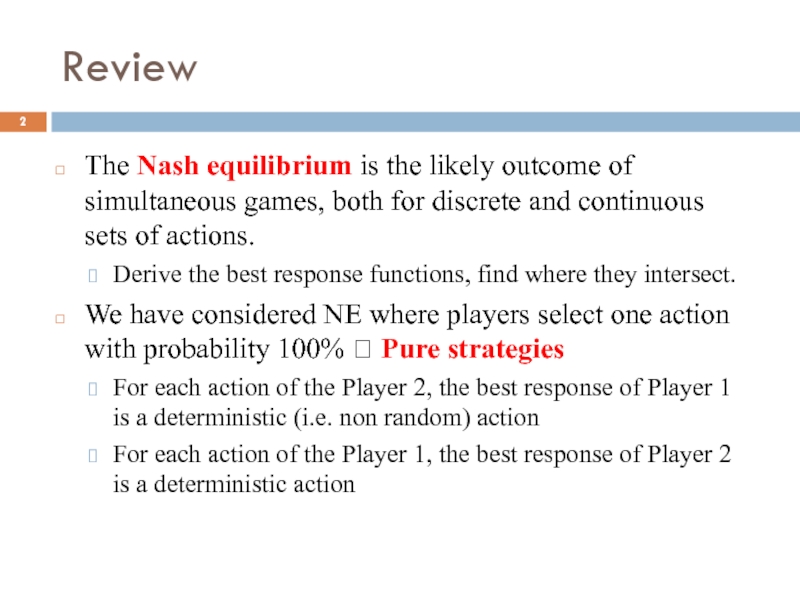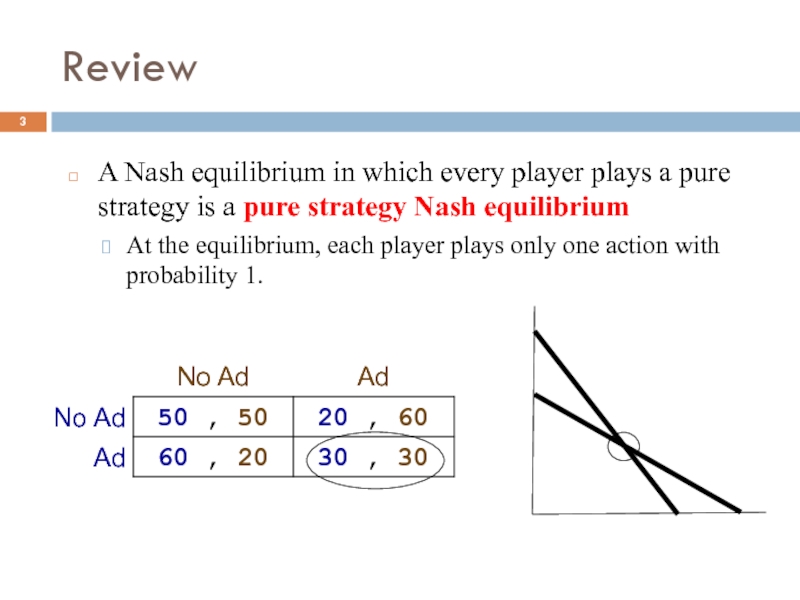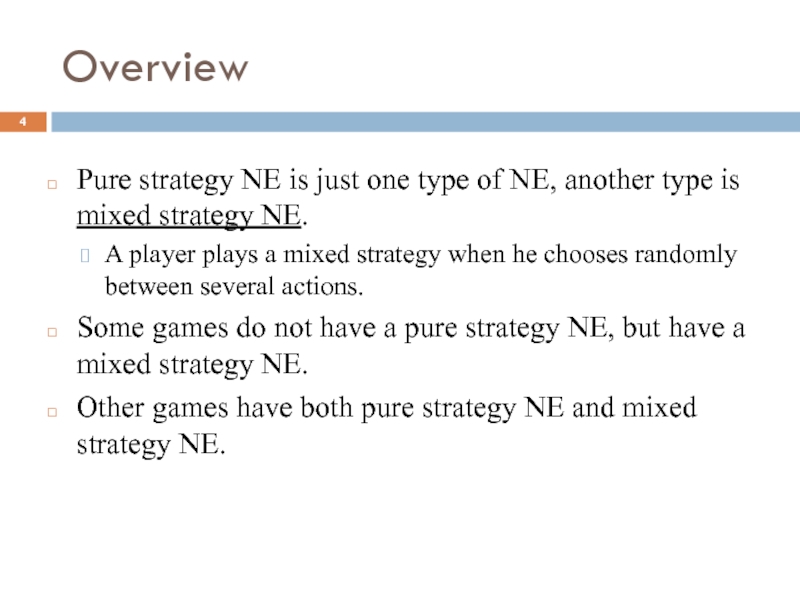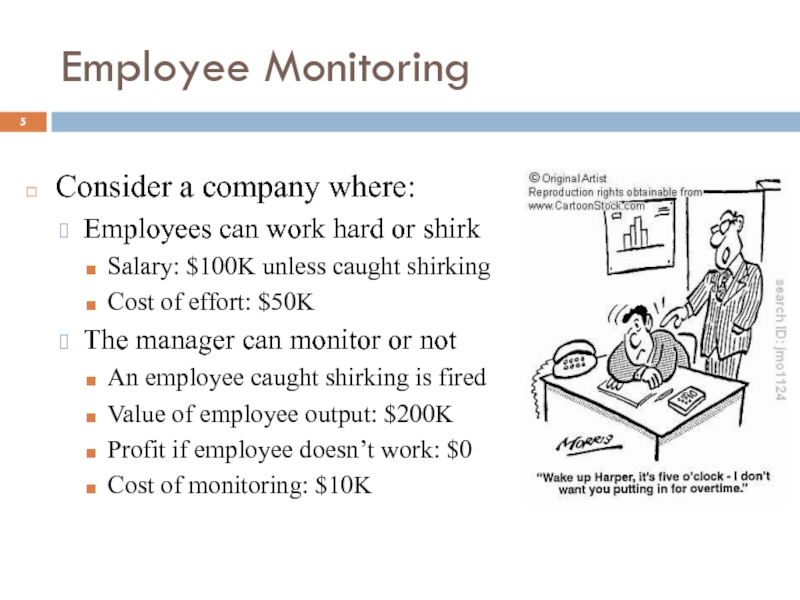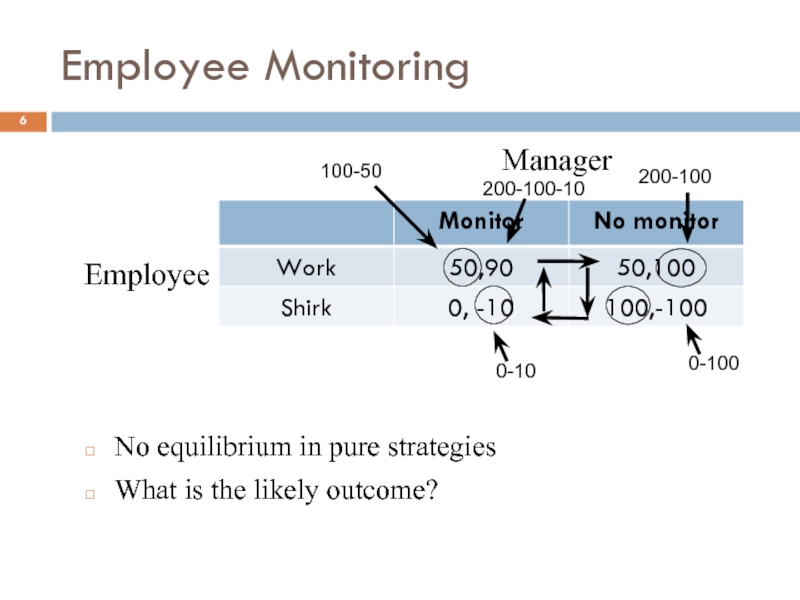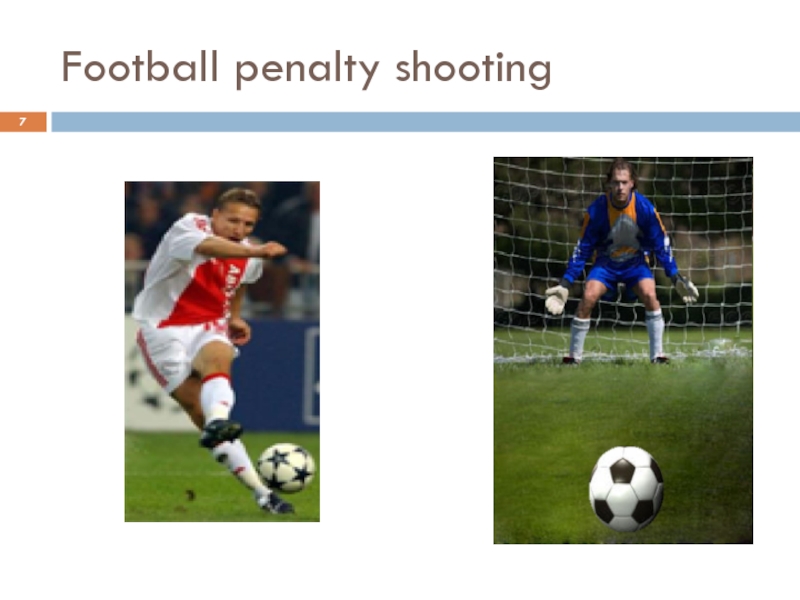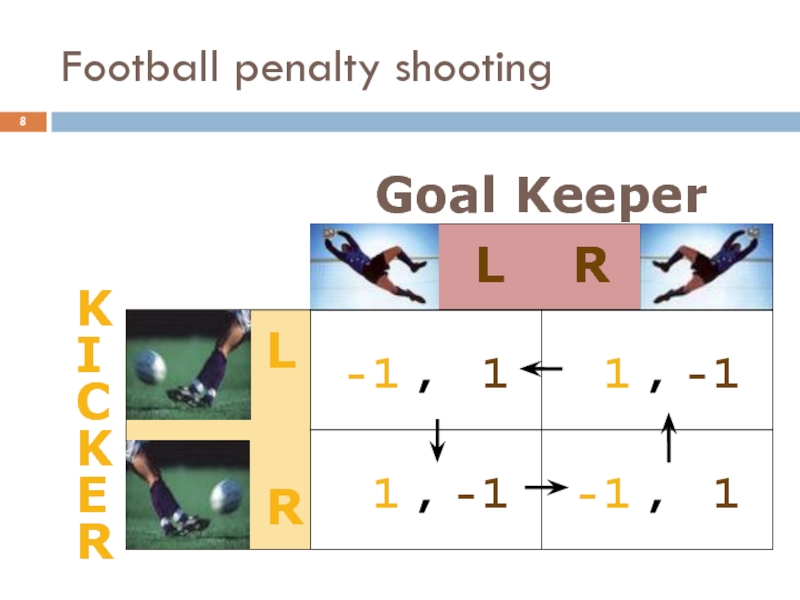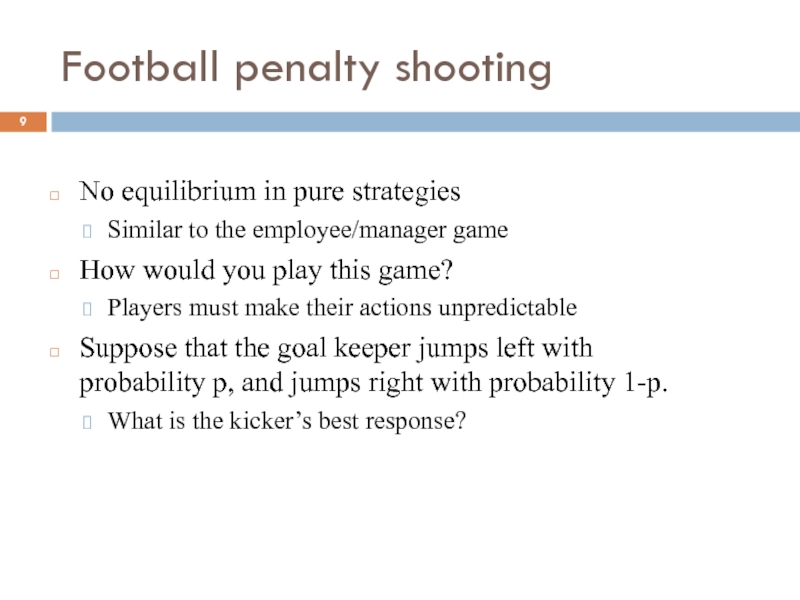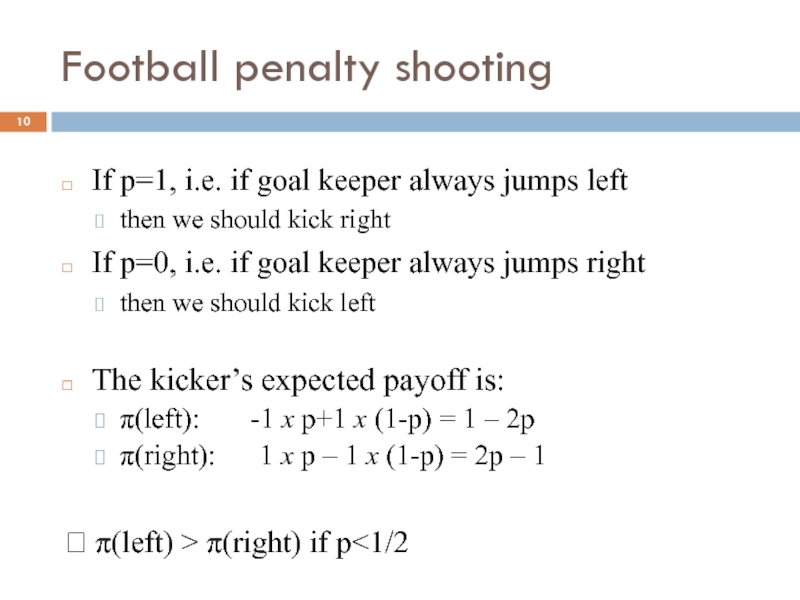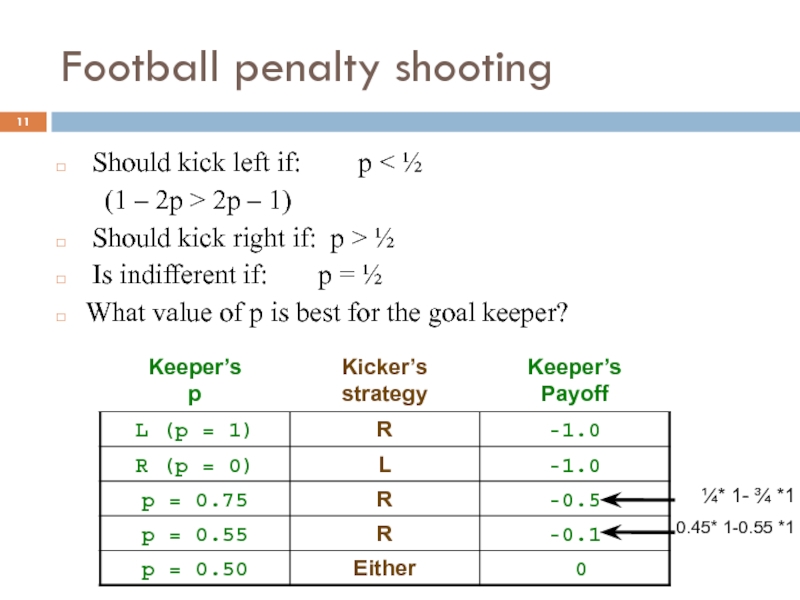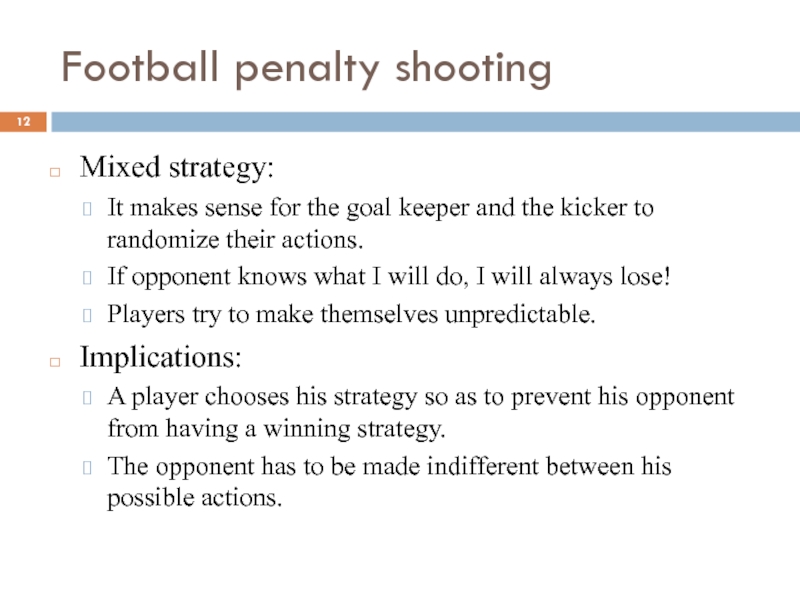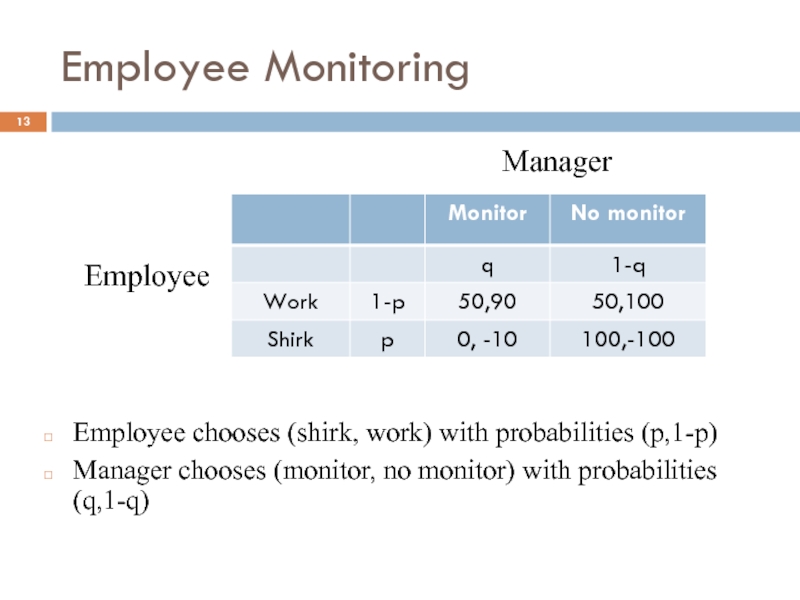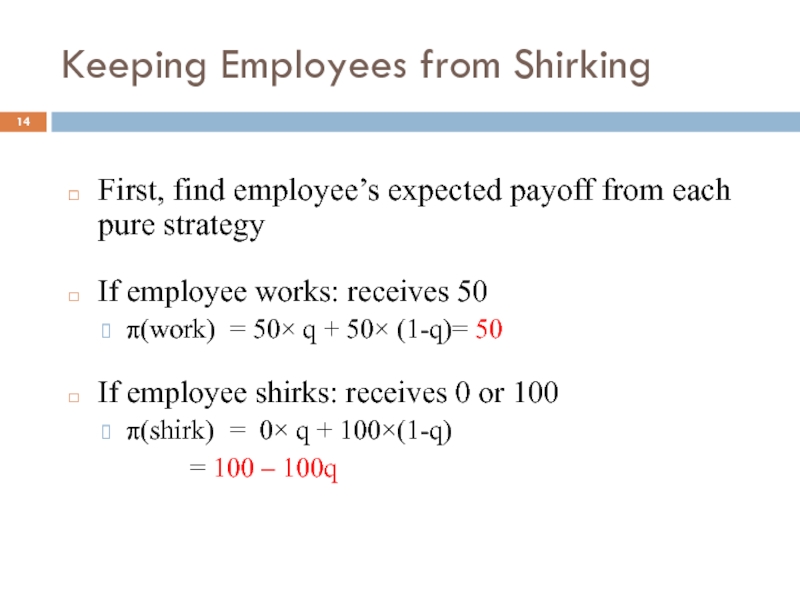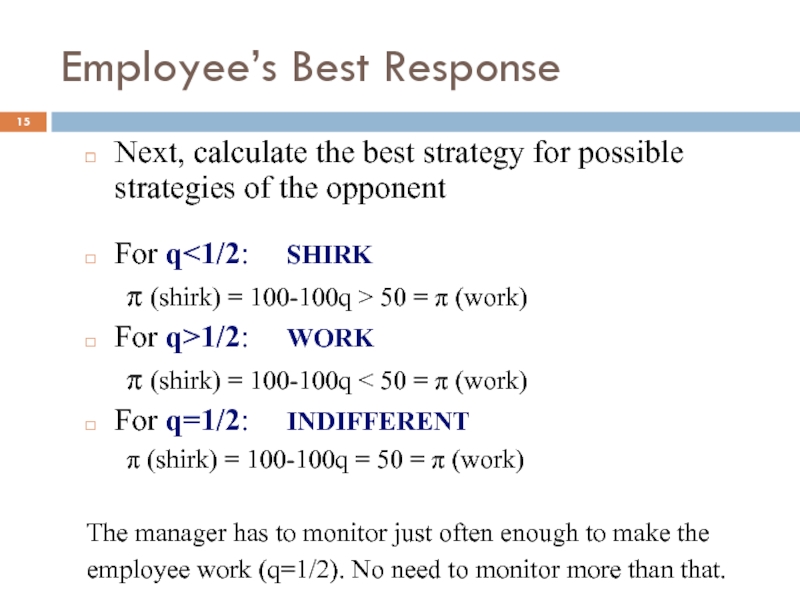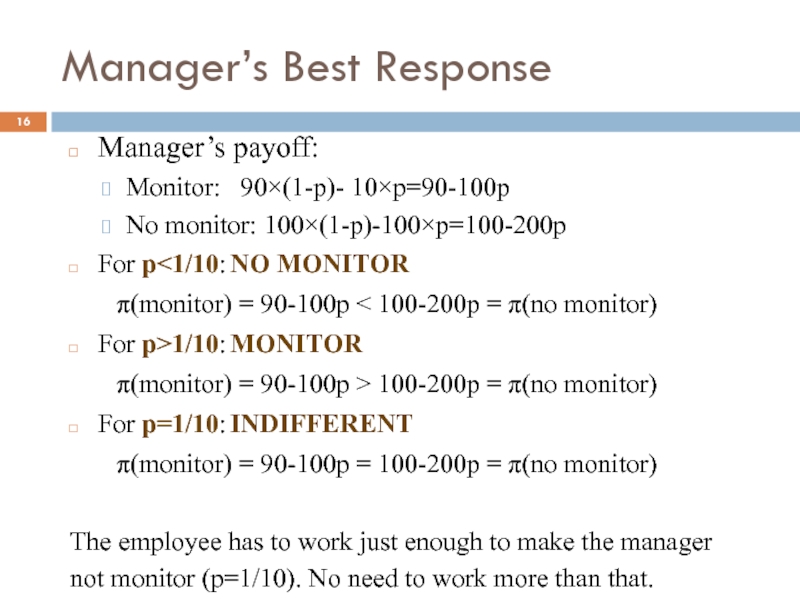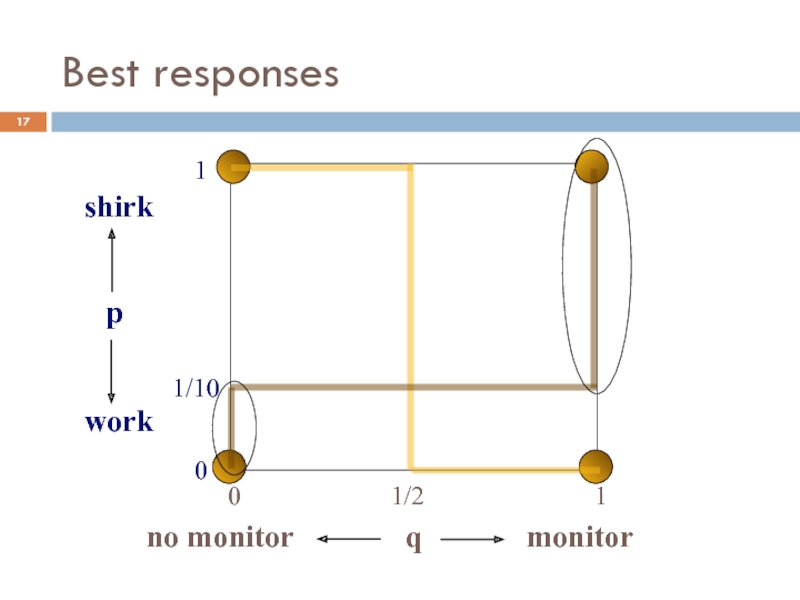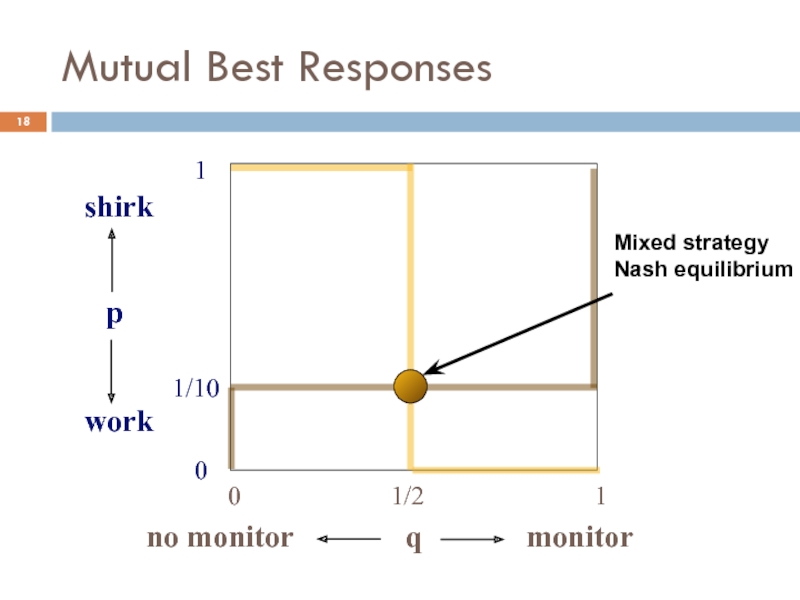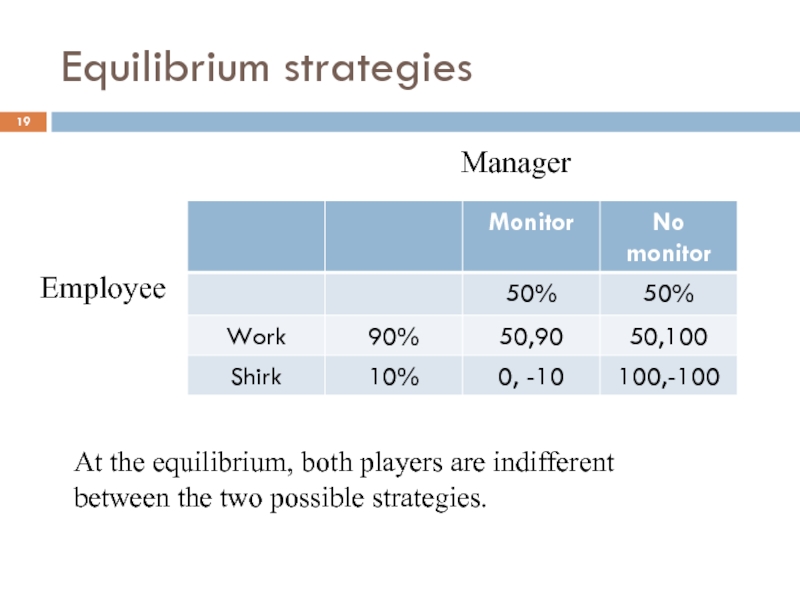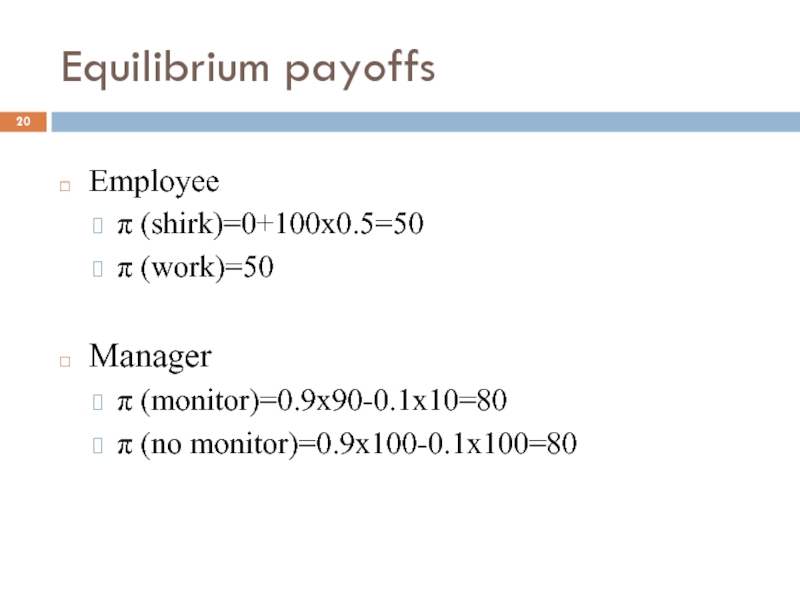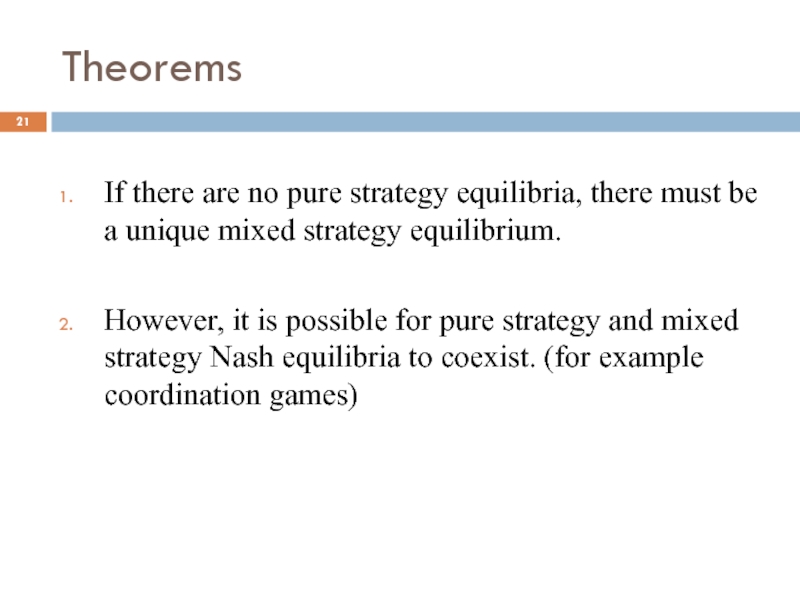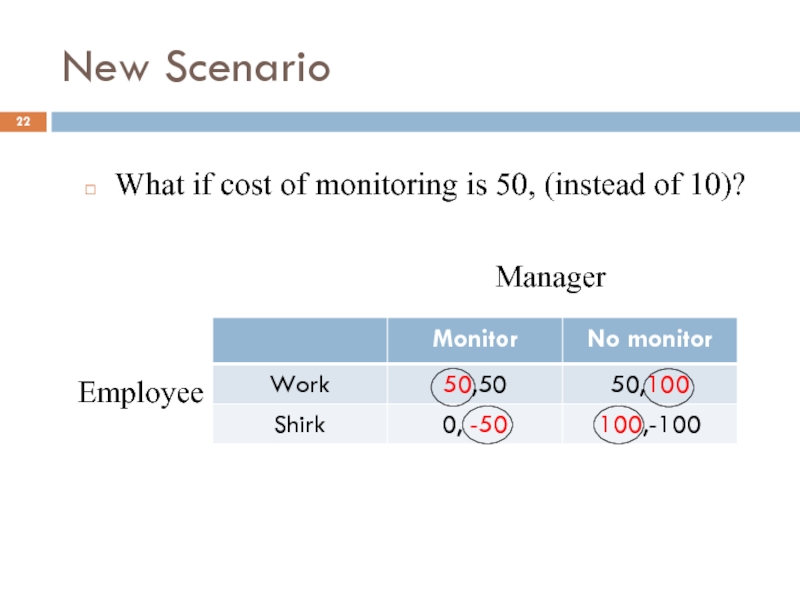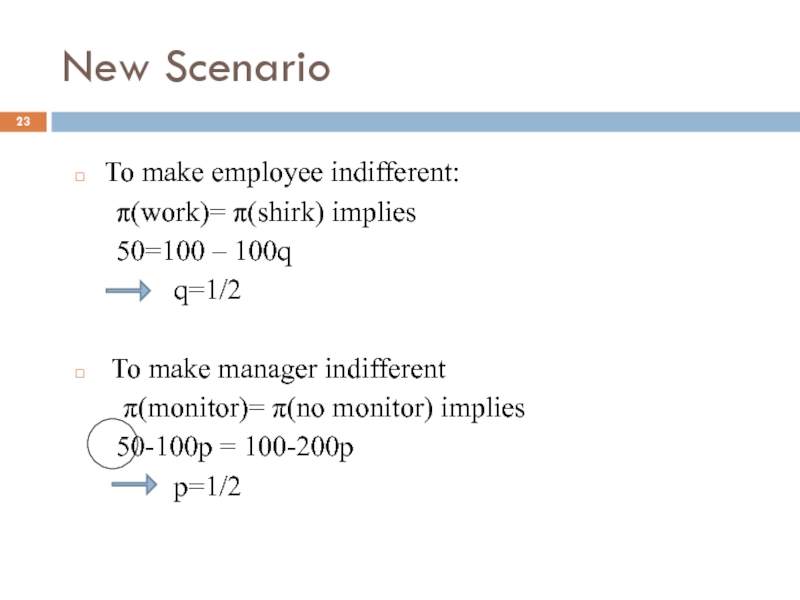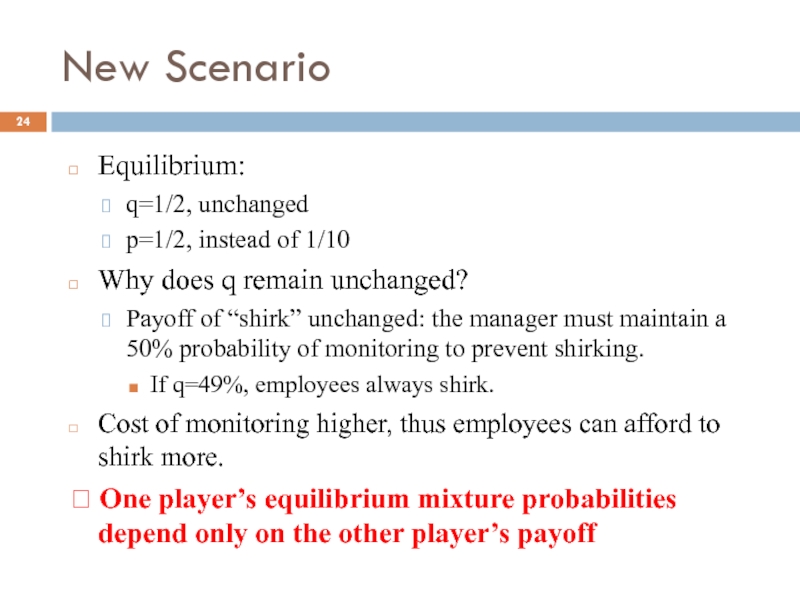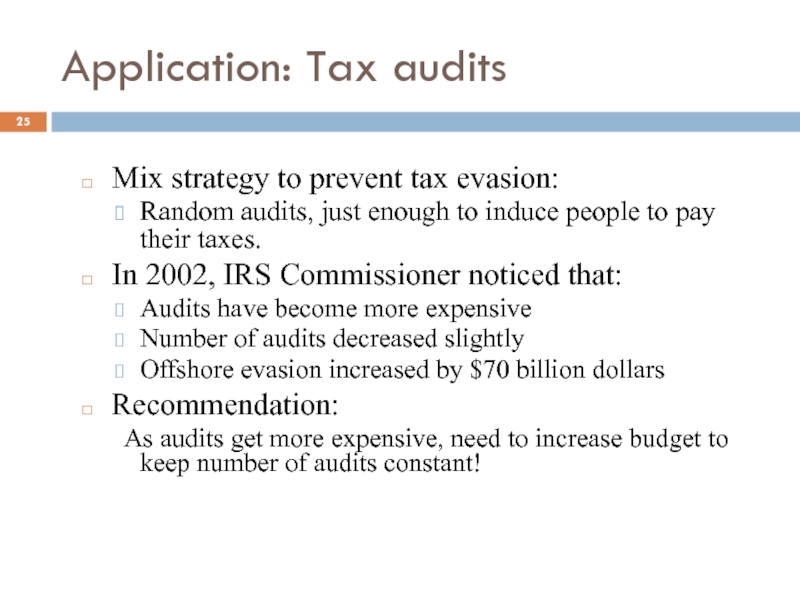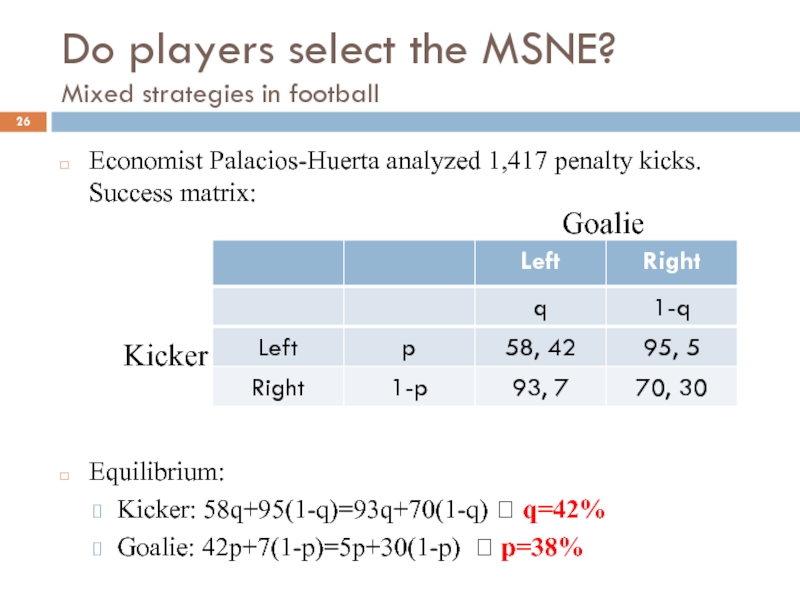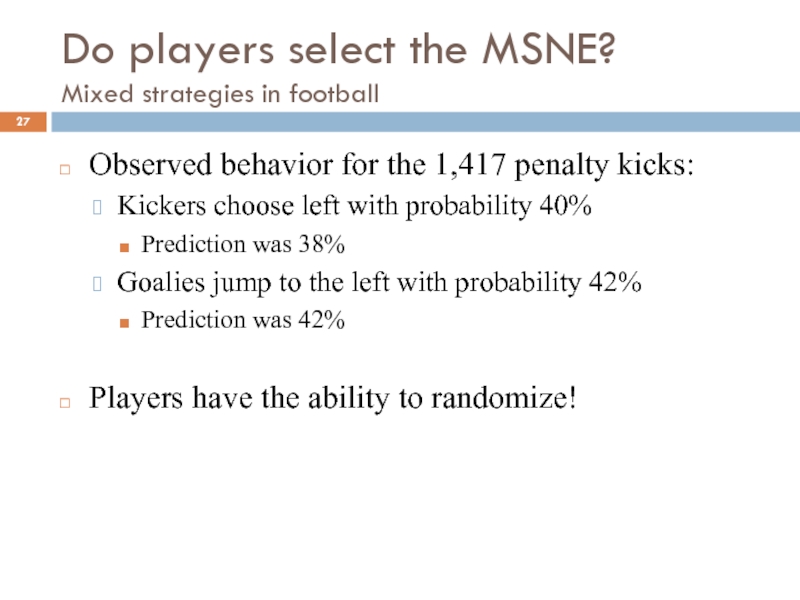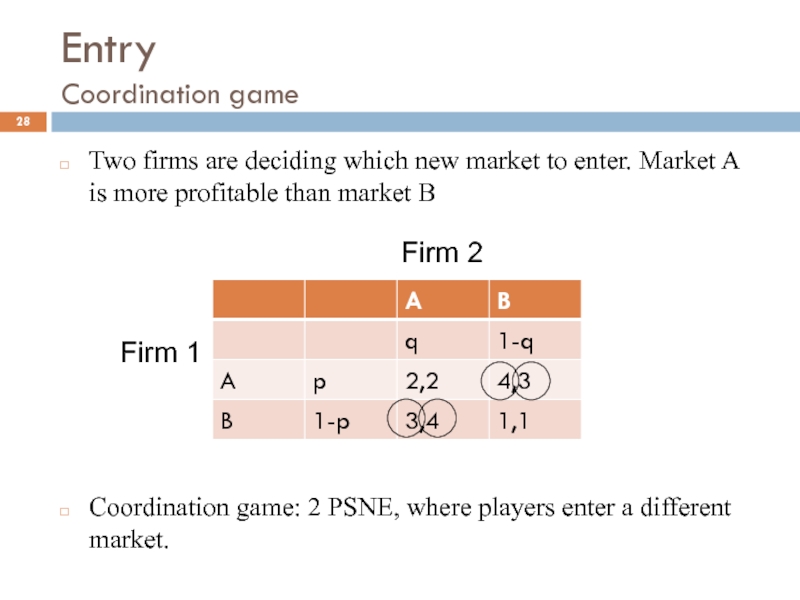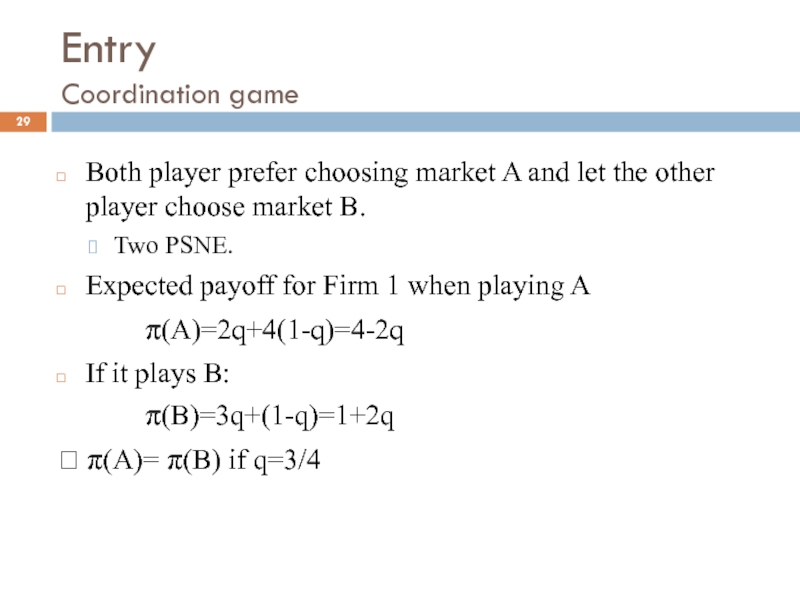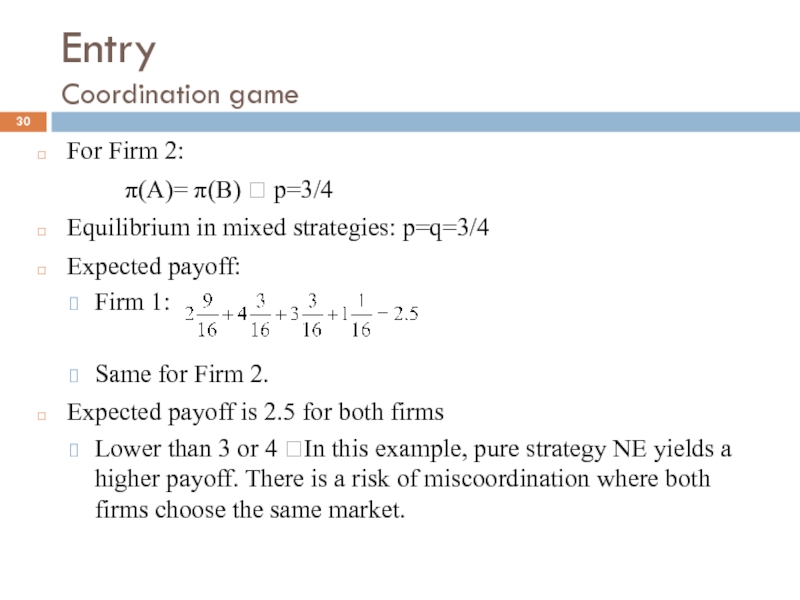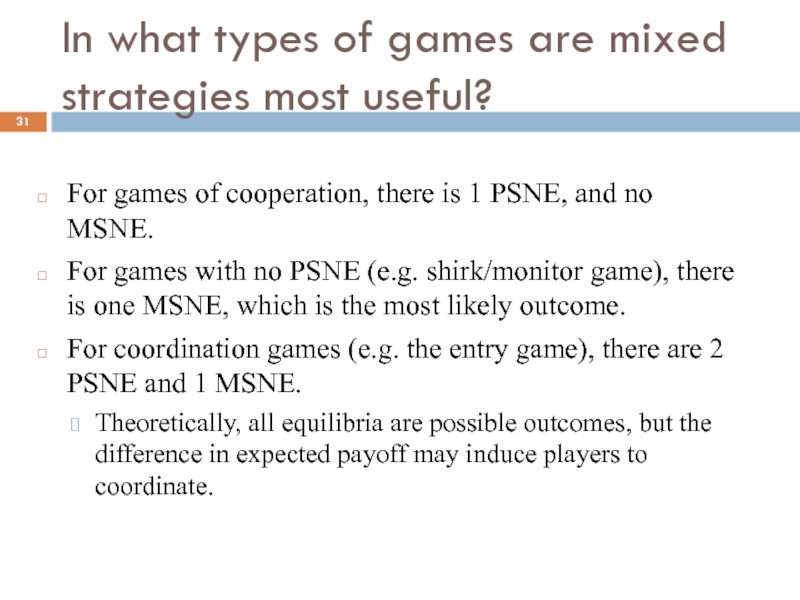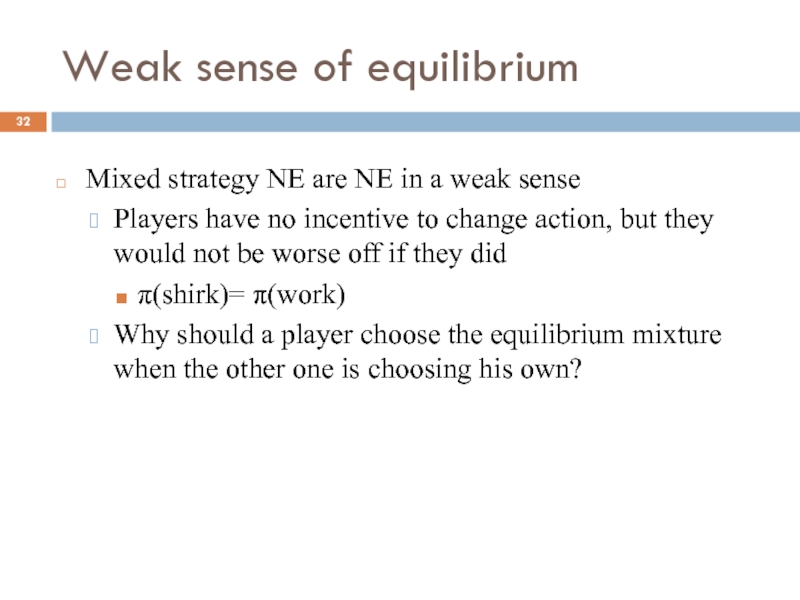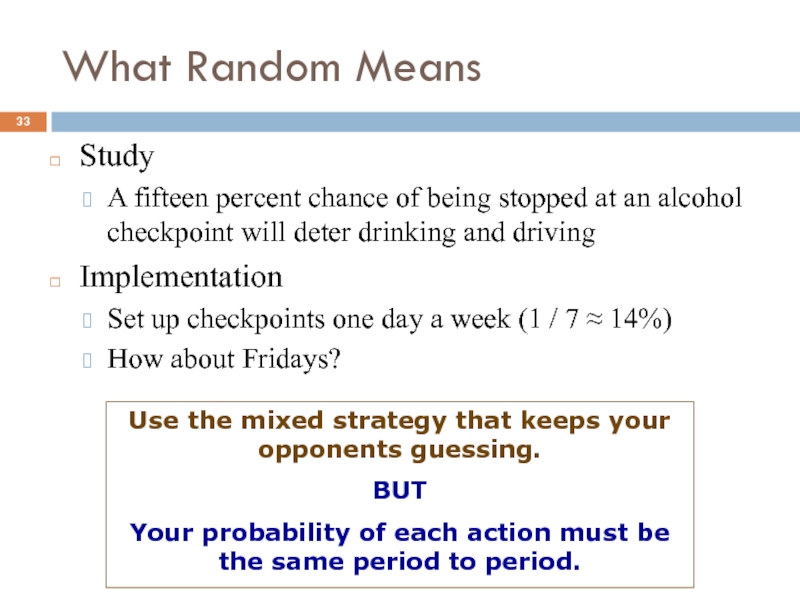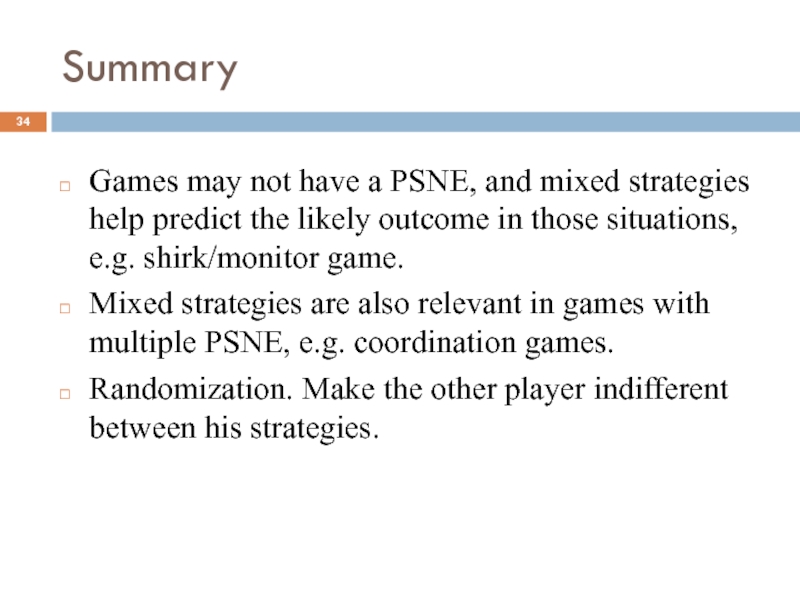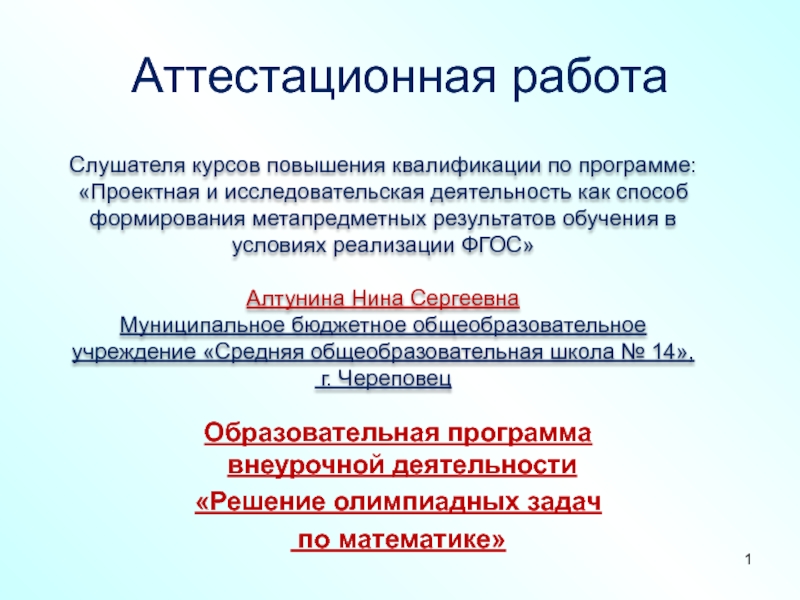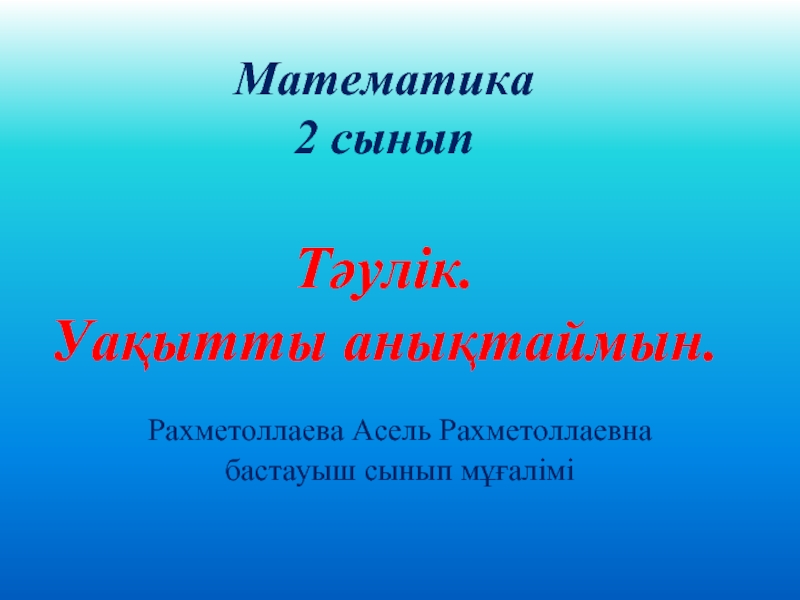- Главная
- Разное
- Дизайн
- Бизнес и предпринимательство
- Аналитика
- Образование
- Развлечения
- Красота и здоровье
- Финансы
- Государство
- Путешествия
- Спорт
- Недвижимость
- Армия
- Графика
- Культурология
- Еда и кулинария
- Лингвистика
- Английский язык
- Астрономия
- Алгебра
- Биология
- География
- Детские презентации
- Информатика
- История
- Литература
- Маркетинг
- Математика
- Медицина
- Менеджмент
- Музыка
- МХК
- Немецкий язык
- ОБЖ
- Обществознание
- Окружающий мир
- Педагогика
- Русский язык
- Технология
- Физика
- Философия
- Химия
- Шаблоны, картинки для презентаций
- Экология
- Экономика
- Юриспруденция
Mixed strategy Nash equilibrium. (Lecture 3) презентация
Содержание
- 1. Mixed strategy Nash equilibrium. (Lecture 3)
- 2. Review The Nash equilibrium is the likely
- 3. Review A Nash equilibrium in which
- 4. Overview Pure strategy NE is just one
- 5. Employee Monitoring Consider a company where: Employees
- 6. Employee Monitoring
- 7. Football penalty shooting
- 8. Football penalty shooting
- 9. Football penalty shooting No equilibrium in pure
- 10. Football penalty shooting If p=1, i.e. if
- 11. Football penalty shooting Should kick
- 12. Football penalty shooting Mixed strategy: It makes
- 13. Employee Monitoring
- 14. Keeping Employees from Shirking First, find employee’s
- 15. Employee’s Best Response Next, calculate the best
- 16. Manager’s Best Response Manager’s payoff: Monitor:
- 17. Best responses q 0 1 1/2 p
- 18. Mutual Best Responses q 0 1 1/2
- 19. Equilibrium strategies
- 20. Equilibrium payoffs Employee π (shirk)=0+100x0.5=50 π (work)=50 Manager π (monitor)=0.9x90-0.1x10=80 π (no monitor)=0.9x100-0.1x100=80
- 21. Theorems If there are no pure strategy
- 22. New Scenario What if cost of monitoring
- 23. New Scenario To make employee indifferent: π(work)=
- 24. New Scenario Equilibrium: q=1/2, unchanged p=1/2, instead
- 25. Application: Tax audits Mix strategy to prevent
- 26. Do players select the MSNE? Mixed strategies
- 27. Do players select the MSNE? Mixed strategies
- 28. Entry Coordination game Two firms are deciding
- 29. Entry Coordination game Both player prefer choosing
- 30. Entry Coordination game For Firm 2:
- 31. In what types of games are mixed
- 32. Weak sense of equilibrium Mixed strategy NE
- 33. What Random Means Study A fifteen percent
- 34. Summary Games may not have a PSNE,
Слайд 2Review
The Nash equilibrium is the likely outcome of simultaneous games, both
Derive the best response functions, find where they intersect.
We have considered NE where players select one action with probability 100% ? Pure strategies
For each action of the Player 2, the best response of Player 1 is a deterministic (i.e. non random) action
For each action of the Player 1, the best response of Player 2 is a deterministic action
Слайд 3Review
A Nash equilibrium in which every player plays a pure strategy
At the equilibrium, each player plays only one action with probability 1.
Слайд 4Overview
Pure strategy NE is just one type of NE, another type
A player plays a mixed strategy when he chooses randomly between several actions.
Some games do not have a pure strategy NE, but have a mixed strategy NE.
Other games have both pure strategy NE and mixed strategy NE.
Слайд 5Employee Monitoring
Consider a company where:
Employees can work hard or shirk
Salary: $100K
Cost of effort: $50K
The manager can monitor or not
An employee caught shirking is fired
Value of employee output: $200K
Profit if employee doesn’t work: $0
Cost of monitoring: $10K
Слайд 6Employee Monitoring
No equilibrium in pure strategies
What is the likely outcome?
Manager
Employee
100-50
200-100-10
200-100
0-10
0-100
Слайд 9Football penalty shooting
No equilibrium in pure strategies
Similar to the employee/manager game
How
Players must make their actions unpredictable
Suppose that the goal keeper jumps left with probability p, and jumps right with probability 1-p.
What is the kicker’s best response?
Слайд 10Football penalty shooting
If p=1, i.e. if goal keeper always jumps left
then
If p=0, i.e. if goal keeper always jumps right
then we should kick left
The kicker’s expected payoff is:
π(left): -1 x p+1 x (1-p) = 1 – 2p
π(right): 1 x p – 1 x (1-p) = 2p – 1
? π(left) > π(right) if p<1/2
Слайд 11Football penalty shooting
Should kick left if: p < ½
(1 – 2p > 2p – 1)
Should kick right if: p > ½
Is indifferent if: p = ½
What value of p is best for the goal keeper?
¼* 1- ¾ *1
0.45* 1-0.55 *1
Слайд 12Football penalty shooting
Mixed strategy:
It makes sense for the goal keeper and
If opponent knows what I will do, I will always lose!
Players try to make themselves unpredictable.
Implications:
A player chooses his strategy so as to prevent his opponent from having a winning strategy.
The opponent has to be made indifferent between his possible actions.
Слайд 13Employee Monitoring
Employee chooses (shirk, work) with probabilities (p,1-p)
Manager chooses (monitor, no
Manager
Employee
Слайд 14Keeping Employees from Shirking
First, find employee’s expected payoff from each pure
If employee works: receives 50
π(work) = 50× q + 50× (1-q)= 50
If employee shirks: receives 0 or 100
π(shirk) = 0× q + 100×(1-q)
= 100 – 100q
Слайд 15Employee’s Best Response
Next, calculate the best strategy for possible strategies of
For q<1/2: SHIRK
π (shirk) = 100-100q > 50 = π (work)
For q>1/2: WORK
π (shirk) = 100-100q < 50 = π (work)
For q=1/2: INDIFFERENT
π (shirk) = 100-100q = 50 = π (work)
The manager has to monitor just often enough to make the
employee work (q=1/2). No need to monitor more than that.
Слайд 16Manager’s Best Response
Manager’s payoff:
Monitor: 90×(1-p)- 10×p=90-100p
No monitor: 100×(1-p)-100×p=100-200p
For p
For p>1/10: MONITOR
π(monitor) = 90-100p > 100-200p = π(no monitor)
For p=1/10: INDIFFERENT
π(monitor) = 90-100p = 100-200p = π(no monitor)
The employee has to work just enough to make the manager
not monitor (p=1/10). No need to work more than that.
Слайд 19Equilibrium strategies
Manager
Employee
At the equilibrium, both players are indifferent between the two
Слайд 20Equilibrium payoffs
Employee
π (shirk)=0+100x0.5=50
π (work)=50
Manager
π (monitor)=0.9x90-0.1x10=80
π (no monitor)=0.9x100-0.1x100=80
Слайд 21Theorems
If there are no pure strategy equilibria, there must be a
However, it is possible for pure strategy and mixed strategy Nash equilibria to coexist. (for example coordination games)
Слайд 23New Scenario
To make employee indifferent:
π(work)= π(shirk) implies
50=100 – 100q
To make manager indifferent
π(monitor)= π(no monitor) implies
50-100p = 100-200p
p=1/2
Слайд 24New Scenario
Equilibrium:
q=1/2, unchanged
p=1/2, instead of 1/10
Why does q remain unchanged?
Payoff of
If q=49%, employees always shirk.
Cost of monitoring higher, thus employees can afford to shirk more.
? One player’s equilibrium mixture probabilities depend only on the other player’s payoff
Слайд 25Application: Tax audits
Mix strategy to prevent tax evasion:
Random audits, just enough
In 2002, IRS Commissioner noticed that:
Audits have become more expensive
Number of audits decreased slightly
Offshore evasion increased by $70 billion dollars
Recommendation:
As audits get more expensive, need to increase budget to keep number of audits constant!
Слайд 26Do players select the MSNE?
Mixed strategies in football
Economist Palacios-Huerta analyzed 1,417
Equilibrium:
Kicker: 58q+95(1-q)=93q+70(1-q) ? q=42%
Goalie: 42p+7(1-p)=5p+30(1-p) ? p=38%
Goalie
Kicker
Слайд 27Do players select the MSNE?
Mixed strategies in football
Observed behavior for the
Kickers choose left with probability 40%
Prediction was 38%
Goalies jump to the left with probability 42%
Prediction was 42%
Players have the ability to randomize!
Слайд 28Entry
Coordination game
Two firms are deciding which new market to enter. Market
Coordination game: 2 PSNE, where players enter a different market.
Firm 1
Firm 2
Слайд 29Entry
Coordination game
Both player prefer choosing market A and let the other
Two PSNE.
Expected payoff for Firm 1 when playing A
π(A)=2q+4(1-q)=4-2q
If it plays B:
π(B)=3q+(1-q)=1+2q
? π(A)= π(B) if q=3/4
Слайд 30Entry
Coordination game
For Firm 2:
π(A)= π(B) ? p=3/4
Equilibrium in mixed strategies:
Expected payoff:
Firm 1:
Same for Firm 2.
Expected payoff is 2.5 for both firms
Lower than 3 or 4 ?In this example, pure strategy NE yields a higher payoff. There is a risk of miscoordination where both firms choose the same market.
Слайд 31In what types of games are mixed strategies most useful?
For games
For games with no PSNE (e.g. shirk/monitor game), there is one MSNE, which is the most likely outcome.
For coordination games (e.g. the entry game), there are 2 PSNE and 1 MSNE.
Theoretically, all equilibria are possible outcomes, but the difference in expected payoff may induce players to coordinate.
Слайд 32Weak sense of equilibrium
Mixed strategy NE are NE in a weak
Players have no incentive to change action, but they would not be worse off if they did
π(shirk)= π(work)
Why should a player choose the equilibrium mixture when the other one is choosing his own?
Слайд 33What Random Means
Study
A fifteen percent chance of being stopped at an
Implementation
Set up checkpoints one day a week (1 / 7 ≈ 14%)
How about Fridays?
Use the mixed strategy that keeps your opponents guessing.
BUT
Your probability of each action must be the same period to period.
Слайд 34Summary
Games may not have a PSNE, and mixed strategies help predict
Mixed strategies are also relevant in games with multiple PSNE, e.g. coordination games.
Randomization. Make the other player indifferent between his strategies.
